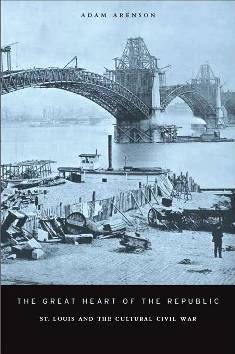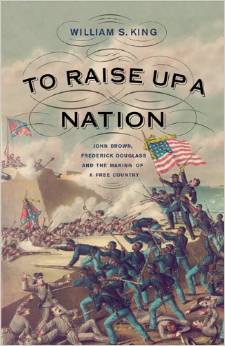The Great Heart of the Republic: St. Louis and the Cultural Civil War by Adam Arenson. Harvard University Press, 2011. Cloth, ISBN: 0674052889. $36.50.
 Adam Arenson’s engaging study of mid-nineteenth-century St. Louis is a story of national potential and national failure. Located at the intersection of North, South, and West, St. Louis requires us to re-frame the parameters of civil war. The military conflict between 1861 and 1865 was an escalation of a larger cultural civil war, running from 1848 to 1877, in which northerners, southerners, and westerners competed to define the meaning of Manifest Destiny and national progress. The western leaders of St. Louis struggled to build a national city in the midst of these cultural divisions, and their regional vision for St. Louis’s greatness often clashed with national policies dealing with expansion, emancipation, and reconstruction.
Adam Arenson’s engaging study of mid-nineteenth-century St. Louis is a story of national potential and national failure. Located at the intersection of North, South, and West, St. Louis requires us to re-frame the parameters of civil war. The military conflict between 1861 and 1865 was an escalation of a larger cultural civil war, running from 1848 to 1877, in which northerners, southerners, and westerners competed to define the meaning of Manifest Destiny and national progress. The western leaders of St. Louis struggled to build a national city in the midst of these cultural divisions, and their regional vision for St. Louis’s greatness often clashed with national policies dealing with expansion, emancipation, and reconstruction.
Central to Arenson’s argument is the idea that the Civil War should be understood as a three-way struggle for the cultural destiny of the United States in which the West figured prominently. This region has often been overlooked by scholars who have focused on the cultural divide between North and South over slavery’s expansion. But westerners – political leaders and economic boosters – had their own plans for the newly acquired territories. These plans would allow the West to develop into the most powerful region of the United States, eclipsing the East economically and culturally. Indeed, during the 1850s, St. Louisans established Washington University and the Mercantile Library to bring education and culture to the city. At the same time, politicians and economic boosters attempted to establish a route for the transcontinental railroad that would pass through St. Louis. Because they envisioned a nationally prominent future for St. Louis, the city’s leaders were pragmatic compromisers when it came to the debate over slavery. Arsenon argues that slavery’s existence in the city was tied, historically, to the rivers. Freedom was near, slavery was violent, and although white St. Louisans were divided on the issue of emancipation, some politicians cautiously advocated gradual emancipation, and the Republican Party gained traction as some city dwellers began to embrace of vision of national expansion that included railroads and free-labor agriculture. Even after the Dred Scott decision (1857) seemingly solidified “southern property restrictions,” Arenson finds that St. Louisans, though divided, continued to look for compromise on the issue of slavery in the hope of achieving national unity (106).
If the sectional crisis complicated St. Louis’s bid for national importance, the war and Reconstruction further hurt the city’s chances to achieve great cultural and economic prominence. The city remained firmly under federal control, but deeply divided. German Unionists debated the meanings of loyalty and neutrality. Confederate sympathizers and those suspected of disloyalty were harassed. African Americans fought for freedom, while most white St. Louisans debated the extent to which emancipation should figure in to the city’s future. All the while, the city’s residents continued to look beyond the war with the hope that St. Louis would emerge as a power center in the West. To that end, the city’s residents established the Western Sanitary Commission, which rivaled its eastern counterpart in providing aid to the Union war effort. Despite these efforts, the war and the Union Army’s policies left Missourians divided and suspicious. African Americans celebrated emancipation by establishing the Lincoln Institute in St. Louis, but their white counterparts acknowledged slavery’s end more cautiously and ignored African Americans’ pleas for citizenship. Economic ties to the Confederacy wrecked the city’s aspirations for a transcontinental railroad. Adding to the disappointment was a failed bid to move the nation’s capital to the city.
Caught in the midst of the cultural civil war, St. Louis failed in its bid for national distinction. The railroad traveled through Omaha. Chicago boomed. And St. Louis found itself immersed in economic and political fraud and further prevented from growing because of local annexation conflicts. In the end, the city became “the place where dramatic cultural gestures were not fulfilled” (222). By looking at St. Louis – the place where northern, southern, and western values collided – Arenson argues persuasively that we can better understand the ways in which civil war left the nation profoundly altered, but not transformed, and still deeply divided.
Arenson’s study and his conclusions are thought-provoking, but his assertion that the Civil War was a three-sided cultural struggle involving westerners needs further unpacking. Arenson suggests that this cultural civil war was a debate over the ways in which the “vast lands and diverse peoples of the Mexican Cession [would] be integrated into the United States” (200). But in his study, it is not completely clear how St. Louis represented a third, western, side in the debate. Its population comprised a particularly volatile mix of slave-holders, free and enslaved African Americans, immigrants, and transplanted northern Whigs. All of these people had competing views of westward expansion, slavery, and national progress, but such disagreements also appeared elsewhere. Did St. Louis differ markedly from Louisville or Cincinnati? Was its pragmatism western or simply a consequence of its being a border city? In short, while it seems quite plausible that westerners – the diverse peoples of the Mexican Cession – had a large stake in the cultural civil war, in this context, the St. Louisans seem barely western. Perhaps this is not a short-coming of Arenson’s study as much as it is an indication that scholars need to further re-think the cultural clash resulting from Manifest Destiny – to further understand how Californians, Mormons, Native Americans, and other conquered peoples also understood the conflict.
Regardless, many scholars will find this study valuable. It explores the contested nature of emancipation, the complicated politics of loyalty on the North-South-West border, and the incompatible visions of economic and cultural expansion in an age of sectional discord. Finally, as any successful study should, it raises complicated questions about the ways we frame the Civil War, Reconstruction, and their legacies.
Megan L. Bever is a Ph.D. Candidate in History at the University of Alabama.
